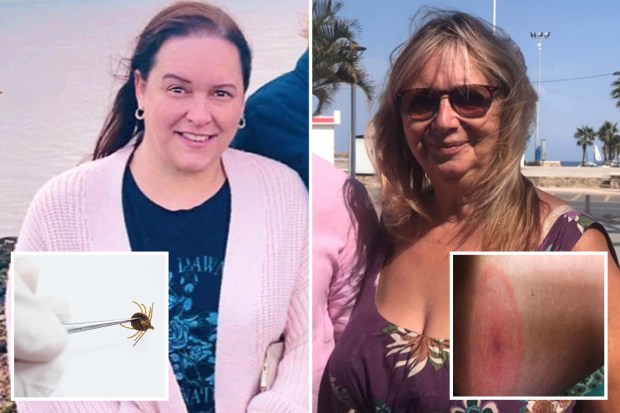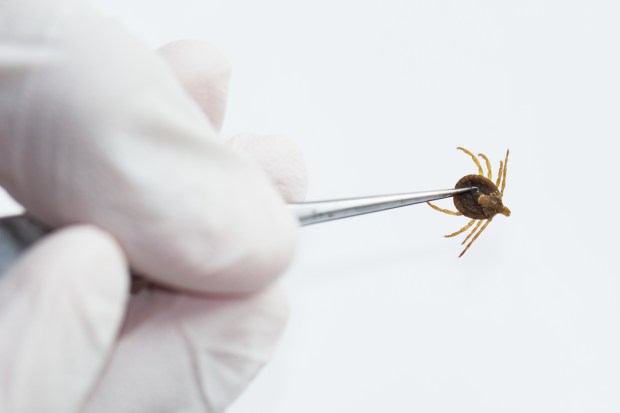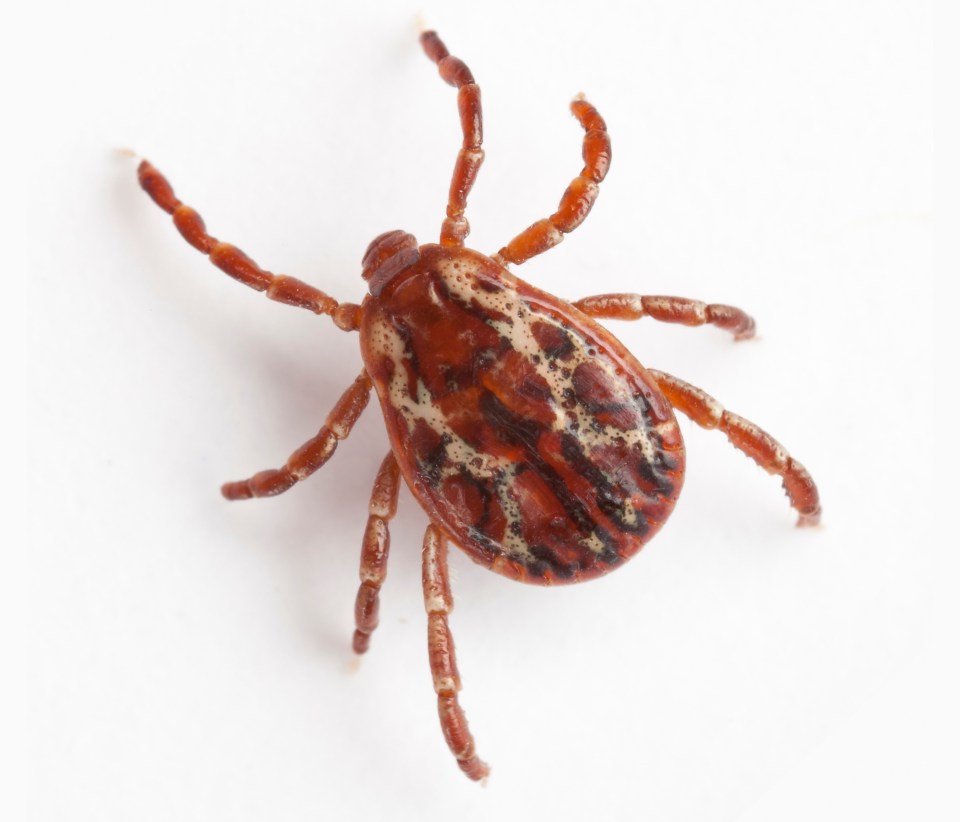I was bitten by a tick and got Lyme disease – it’s ruined my life

THE recent heatwave has prompted alerts about sunburn, heat exhaustion and dehydration, but now experts are warning of another peril – TICKS.
The heat, and thunderstorms, have created the perfect breeding ground for the pesky bloodsuckers.
And if you are unlucky enough to be bitten, you could be at risk of Lyme disease, a bacterial infection that can cause a LIFETIME of debilitating symptoms.
Model Bella Hadid, singers Justin Bieber, Avril Lavigne and Shania Twain, and ex-England rugby player Matt Dawson, have all spoken about their struggles with the condition.
A recent spike in UK cases, and surging numbers worldwide possibly fuelled by climate change, have sparked concern.
But many victims, and even doctors, are slow to spot symptoms — which can be confused with Covid and flu.
Danger zones include long grass and woodlands, and an early sign you have been bitten by a tick carrying Lyme disease — not all do — may be a circular or oval rash around the bite.
Often pink, red or purple — and lighter or darker at the centre, like a bull’s eye — it may spread slowly but is rarely hot or itchy.
Groggy and aching
It usually appears after one to four weeks but can take up to three months to show, and can last several weeks.
But many cases of Lime disease do not involve a rash.
Flu-like symptoms may also follow, with heavy tiredness.
If the illness progresses, it can even lead to short-term memory loss, facial palsy and heart trouble.
As with many things, early treatment helps.
GPs may prescribe antibiotics, and if symptoms persist refer you to a specialist for further blood tests.
The advice is to cover up in long grass or woods.
Ticks are hard to spot until you have been bitten and see a dark lump — likely painless at first, as the bite contains mild anaesthetic.
Ticks range from pinhead to marble size, growing as they suck your blood.
They are best plucked carefully with tweezers or by hand, pressing close to the skin, see top right. Then the wound must be washed.
But poor diagnosis, and frequent long-term illness, are playing havoc with lives.
Nursery worker Kelly Allaway was bitten last September and has been so ill she has had to put her job on hold.
She only realised something was wrong when a rash developed on her leg and she woke one day feeling unwell.
Kelly, 44, from Bristol, says: “I felt like an elephant had sat on my neck — I was groggy and aching all over.
“I had no idea about Lyme disease but sent my GP a picture of the rash.”
She was given antibiotics but says: “I was unable to work due to horrific insomnia and headaches.
“I had to see three different GPs and complain to my practice before I was prescribed more antibiotics.
“One locum I saw even told me Lyme disease doesn’t exist in the UK.”
Similarly, Debbie Flay, 62, also from Bristol, has seen her life turned upside down, having to retire early from running a tutoring business.
After she was bitten in August 2017, five GPs dismissed her concerns and refused to prescribe antibiotics.
Despite a later positive test, she and husband Trevor have since spent £5,000 on private consultations and prescriptions.
She says: “My bite wasn’t itchy at first but did look different.
“At my son Dan’s wedding a pharmacist friend noticed a big, red rash and told me to call my doctor.
“By then I had headaches, a sore throat, fatigue and flu-like symptoms.”
She was offered an appointment with a nurse ten days later. They advised a blood test. But she had read that a test before six weeks, when antibodies tend to develop, might return negative. So she waited.
Four weeks later, a test came back negative. She was in chronic pain and unable to sleep — yet her GP insisted it was not Lyme disease and refused her antibiotics.
She says: “I was so weak, I couldn’t fight back so I had to bring my husband with me to FOUR more appointments. We saw a different GP each time, and one even told me I was ‘just suffering with depression’.”
After finally being sent to an infectious diseases specialist, a second test also came back negative.
By this time, Debbie had blood spots all over her body — but doctors put it down to age.
Finally, a third test came back positive, only for Debbie’s doctor to dismiss the result.
She says: “Unable to work or function, I finally found a infectious disease consultant in Dublin, Professor Jack Lambert, who was very knowledgeable on tick-borne diseases.
“Ten months after my bite and hardly able to walk, I finally had my appointment, in June 2019. That gave me hope, and when he acknowledged Lyme disease and my symptoms, the relief was overwhelming.
“I was prescribed triple antibiotics in three-month bursts — seeing him every three months for a blood test — and lots of supplements and herbs. It took nearly a year of that, going to and from Dublin.”
Potential epidemic
The private care has cost thousands and Debbie adds: “I have relapses — it’s like crashing, if I overdo things.
"I haven’t been able to work since. When I was bitten, I was running a successful tutoring business and walking 10km every day with our dog Ronnie. But I’ve had to retire early and I miss my work. I had great relationships with the kids and parents.
“If I’d had antibiotics earlier, I’d be much better. We couldn’t have pushed any harder but even when my husband came with me, they just rolled their eyes. It’s a disgrace how little some in the NHS know about Lyme disease. I’m one of thousands who feel let down.”
Debbie is now backing the charity ’s campaign , for greater awareness.
But the charity warns of an “explosion” in cases, up 65 per cent each year — and a potential epidemic by 2028.
Telecom tycoon John Caudwell has even set up his own charity, , to fund research, after 11 of his family, including himself, have battled with chronic Lime disease.
Howard Carter, a bite-prevention expert and government advisor, says the disease is “a complete mystery to most of us in the UK”.
He adds: “Most of us are aware of mosquito and jellyfish dangers, but when it comes to ticks, we’re in the dark.”
He fears Public Health England figures, citing 2,000 to 3,000 cases a year in the UK, are “just the tip of the iceberg”. One charity estimates there could be up to 45,000 new cases every year.
Mr Carter says: “Globally, there’s been an explosion of biting insects, which are coming out earlier every year, giving them a longer season to bite. But too many GPs lack training in Lyme disease.
“And only a third of people who have contracted it present with the classic bull’s-eye rash. Plus GPs don’t always ask the right questions.”
With another heatwave expected soon, Lyme Disease UK is urging people to be on guard.
How to remove a tick

MOST ticks in the UK do not carry the bacteria Borrelia which causes Lyme disease, so even if you do get bitten it does not mean you will become unwell.
Ticks have to be attached to you for 24 hours to infect you and, if you are infected, a rash tends to appear after one to four weeks, though some cases may take longer to show.
If you do notice a tick, it is important to know how to remove it.
Use fine-tip tweezers, not blunt- nosed ones like you use to pluck eyebrows, as this is more likely to crush the tick and leave part of its mouth under your skin.
Grasp the tick as close to the skin as possible and pull upwards. Do not twist or jerk the tick. After you have disposed of it, wash the bite area with antiseptic.
If you are unable to remove the tick successfully, visit a doctor immediately.
For more information and support, go to
Most read in Fabulous
Charity chair Natasha Metcalf says: “It’s great that we all want to enjoy parks and grasslands but just be aware this can be a horrific illness.”
Read More on The Sun
Howard Carter adds: “One of the best preventions is to spray legs with an insect repellent containing PMD, such as Incognito.
“When it comes to ticks and Lyme disease, the old adage ‘prevention is better than cure’ really rings true.”
Tips to prevent being bitten

- Cover up when going out for a walk
- Tuck your trousers into your socks to prevent ticks getting to your skin
- Use insect repellent
- Avoid areas with long grass
- Check for ticks whenever you get home from a walk
- Ask a family member or friend to check areas you might not be able to see or reach, such as behind your neck












